Author: Brian Hall
The use of cereal grains other than barley in beer production has been getting more attention lately due to the growing popularity of New England IPA (NEIPA), a style known for its hazy appearance. Of the many unique components involved in brewing NEIPA, the relatively heavy use of adjuncts seems a key contributor to this haziness. It would appear flaked oats has become commonplace among many brewers of NEIPA, though I’ve seen some recipes that include a portion of wheat malt in the grist, either as the sole adjunct or in combination with others. While this usage may increase haziness, many advocates of the style would contend that’s not the intended goal, but that the haze is merely a byproduct of a process targeted at achieving a creamy mouthfeel.
Similar in many respects, such as possessing higher amounts of beta glucan and proteins, flaked oats and wheat malt differ in ways as well, perhaps the most obvious being that flaked oats aren’t malted. Very simply put, the malting process is responsible for developing the enzymes that ultimately convert the starches in grain into fermentable sugar during the mash– whereas flaked oats cannot self-convert, wheat malt can as it possesses diastatic power similar to barley. Another difference is lipid levels with oats containing more than any other cereal grain, which is purported to impact ester concentrations in the finished beer among other things.
My initial interest in comparing flaked oats to wheat malt in a NEIPA was to see if either created a beer that was perceptibly different in aroma, flavor, or mouthfeel. However, there’s been growing discussion of the alleged fragile nature of this style with photos surfacing of beers that have changed color and flavor within days of being packaged. Given the mounting evidence that oxidation is the culprit, there’s been some speculation the rapidity at which it occurs may be a function of the high proportion of flaked oats often used when making NEIPA. Contradicting claims that flaked oats can actually improve the shelf stability of beer, I became even more curious about how it would compare to the same beer made with wheat malt and decided to put it to the test!
| PURPOSE |
To evaluate the differences between a NEIPA brewed using the same proportion of either flaked oats or wheat malt.
| METHODS |
In order to isolate the impact of the variable as much as possible, I designed a recipe with a simple grist a pretty standard NEIPA hop schedule.
Opacity
Recipe Details
| Batch Size | Boil Time | IBU | SRM | Est. OG | Est. FG | ABV |
|---|---|---|---|---|---|---|
| 5.5 gal | 60 min | 53.3 IBUs | 3.4 SRM | 1.055 | 1.014 | 5.3 % |
| Actuals | 1.055 | 1.012 | 5.6 % | |||
Fermentables
| Name | Amount | % |
|---|---|---|
| Pale Malt (2 Row) US | 8 lbs | 72.73 |
| Flaked Oats OR Wheat Malt | 3 lbs | 27.27 |
Hops
| Name | Amount | Time | Use | Form | Alpha % |
|---|---|---|---|---|---|
| Magnum | 10 g | 60 min | Boil | Pellet | 12 |
| Citra | 32 g | 5 min | Boil | Pellet | 12.3 |
| Mandarina Bavaria | 32 g | 5 min | Boil | Pellet | 9.2 |
| Citra | 30 g | 20 min | Aroma | Pellet | 12.3 |
| Mandarina Bavaria | 30 g | 20 min | Aroma | Pellet | 9.2 |
| Citra | 70 g | 7 days | Dry Hop | Pellet | 12 |
| Mandarina Bavaria | 70 g | 7 days | Dry Hop | Pellet | 9.2 |
| Citra | 32 g | 2 days | Dry Hop | Pellet | 12 |
| Mandarina Bavaria | 32 g | 2 days | Dry Hop | Pellet | 9.2 |
Yeast
| Name | Lab | Attenuation | Temperature |
|---|---|---|---|
| London Ale III (1318) | Wyeast Labs | 73% | 64°F - 74°F |
Notes
| Water Profile: Ca 126 | Mg 0 | Na 0 | SO4 118 | Cl 135 |
Download
| Download this recipe's BeerXML file |
I made a starter of Wyeast 1318 London Ale III yeast the afternoon prior to brewing.
Later that evening, I ran the full volume of water through my RO filter then adjusted it to my target profile.
I started my brew day by plugging in my HotRod Heat Stick to heat the water for the flaked oats batch to strike temperature. Since this variable would require separate mashes, I delayed the start of the wheat malt batch by 20 minutes.
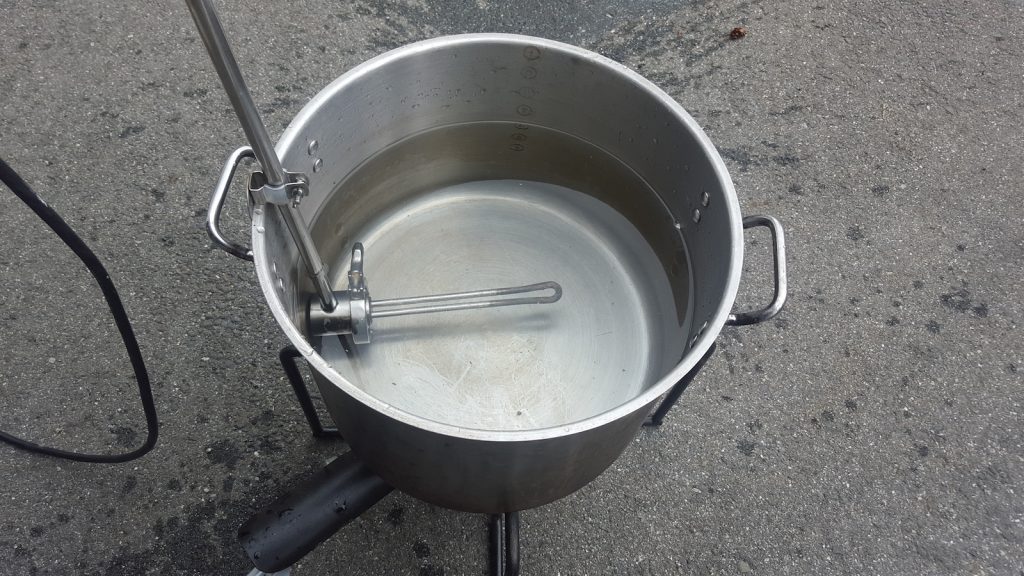
As the water was heating, I called on my faithful assistant for help weighing out and milling the grains directly into BIAB fabric filters.
Once strike temperature was reached, the bags of milled grain were submersed and gently stirred to homogenize.
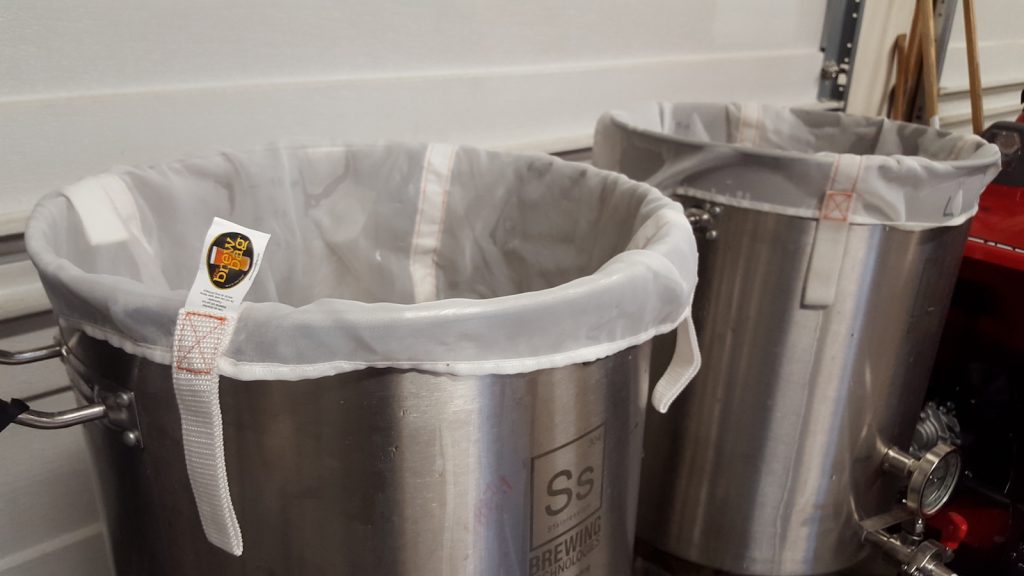
A check of mash temperatures showed both hit my intended target.
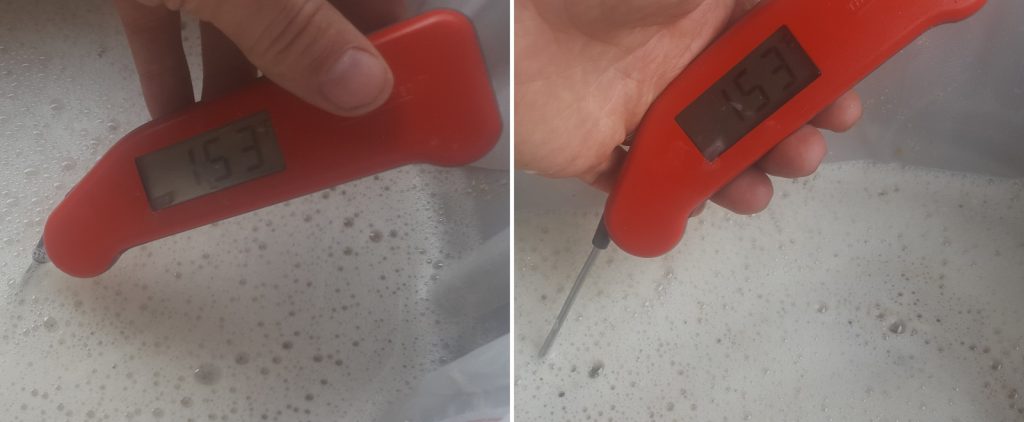
While waiting for the mashes to finish, I measured out the kettle hop additions for both batches.
When the 60 minute mash rests were complete, the bags were removed and the worts were brought to a boil with hops added as stated in the recipe.
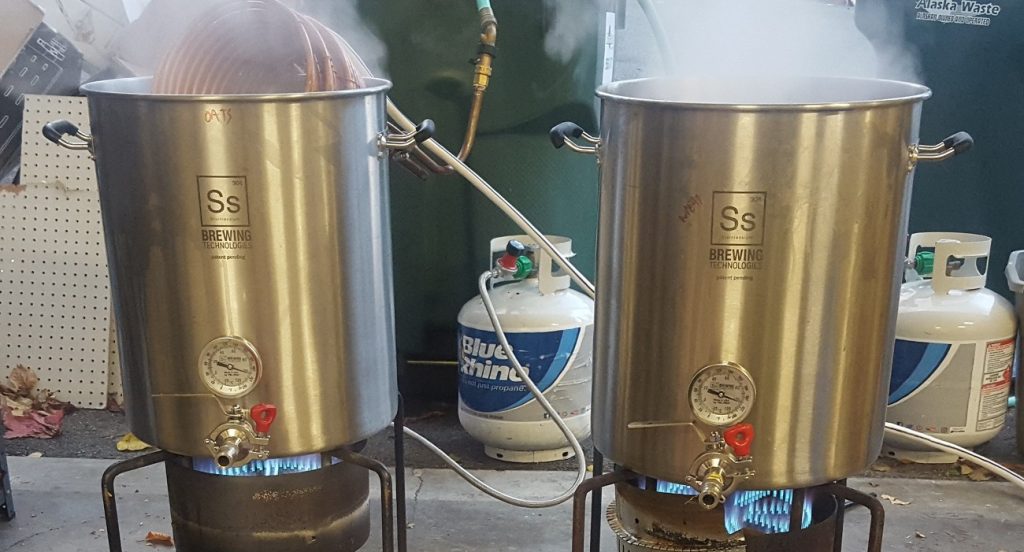
At the end of each 60 minute boil, I quickly chilled the worts to 182°F/83°C and added a charge of hops that I left alone for a 20 minute hop stand.
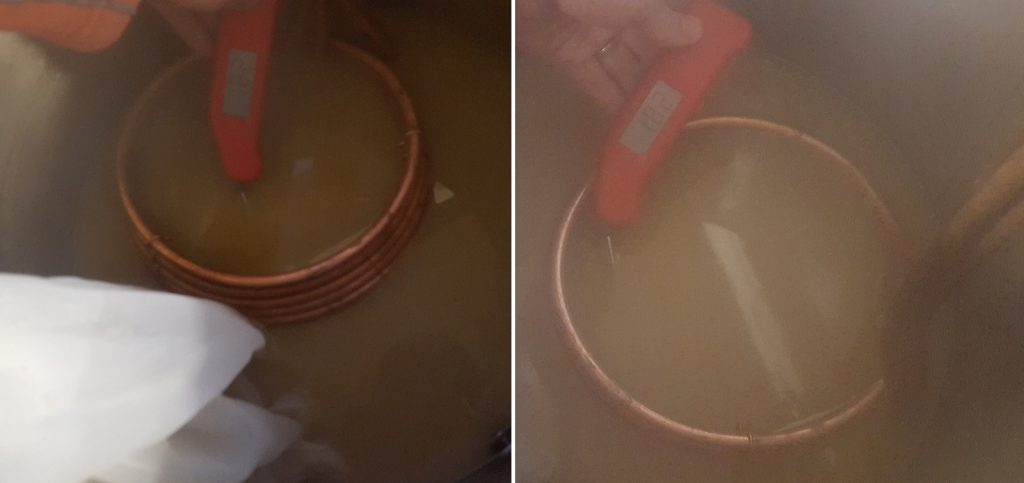
Once the hop stands were done, I finished chilling the worts to my desired pitching temperature of 64°F/18°C then transferred 5.5 gallons/21 liters of each to separate 6.5 gallon glass carboys.
Refractometer readings at this point showed the wort made with flaked oats had a slightly lower OG than the one made with wheat malt.
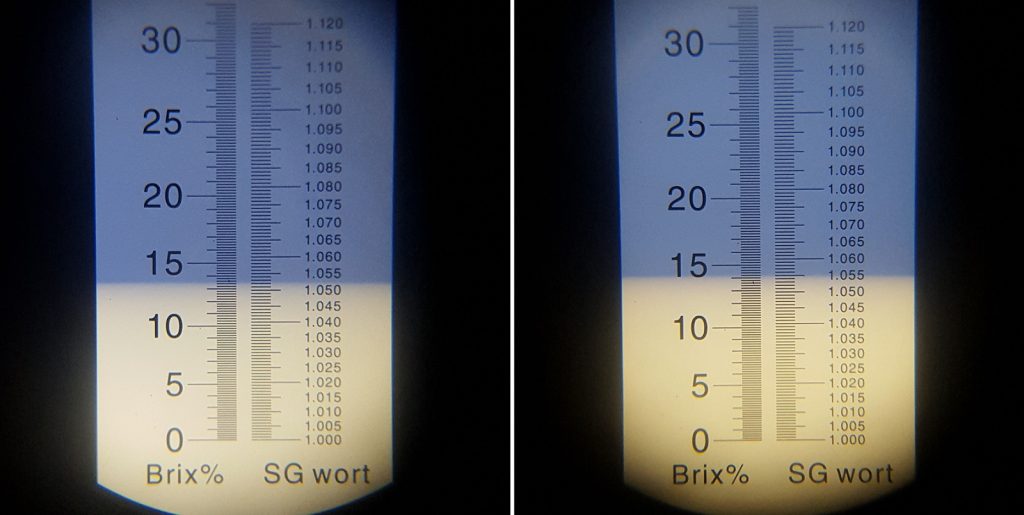
With both carboys placed next to each other in an area that maintains a steady 60°F/16°C, I evenly split the yeast starter between them. Both beers were actively fermenting 16 hours later with no observable differences. I added the biotransformation dry hop addition 2 days later when both beers were at high kräusen.
The beers were then moved to an environment controlled to 68°F/20°C and left to continue fermented for 6 more days, at which point I added another large dry hop charge to both. Hydrometer measurements taken 2 days later, 10 since the beers were brewed, indicated both were done fermenting.
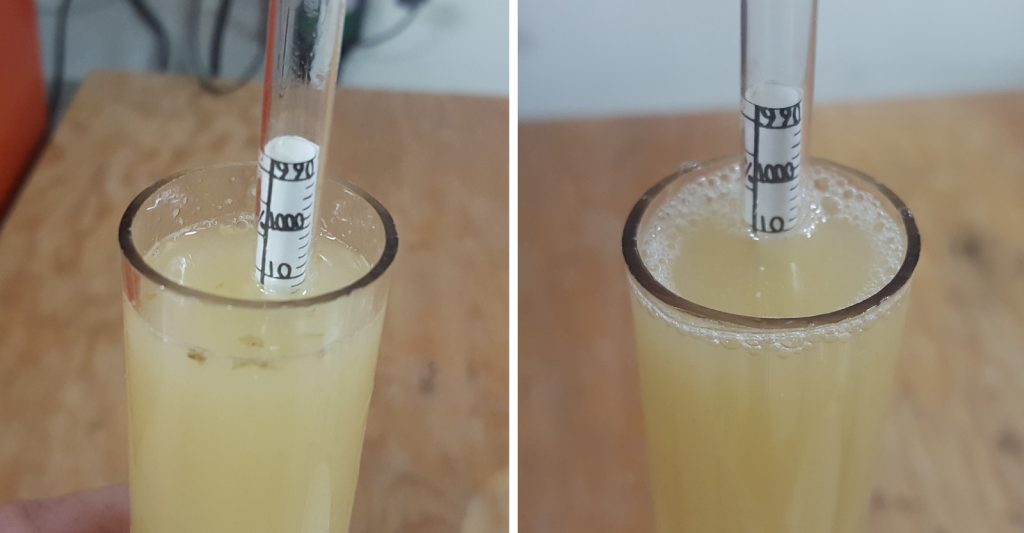
I racked equal amounts of each beer to its own CO2 purged keg under light pressure, careful not to transfer too much trub.
The kegs were then placed in my cool keezer where they were allowed to chill overnight before being burst carbonated. After 5 days of cold conditioning, the beers were ready to serve to participants. Similar to my observation of wort color, the wheat malt beer was ever so slightly darker than the one made with flaked oats.
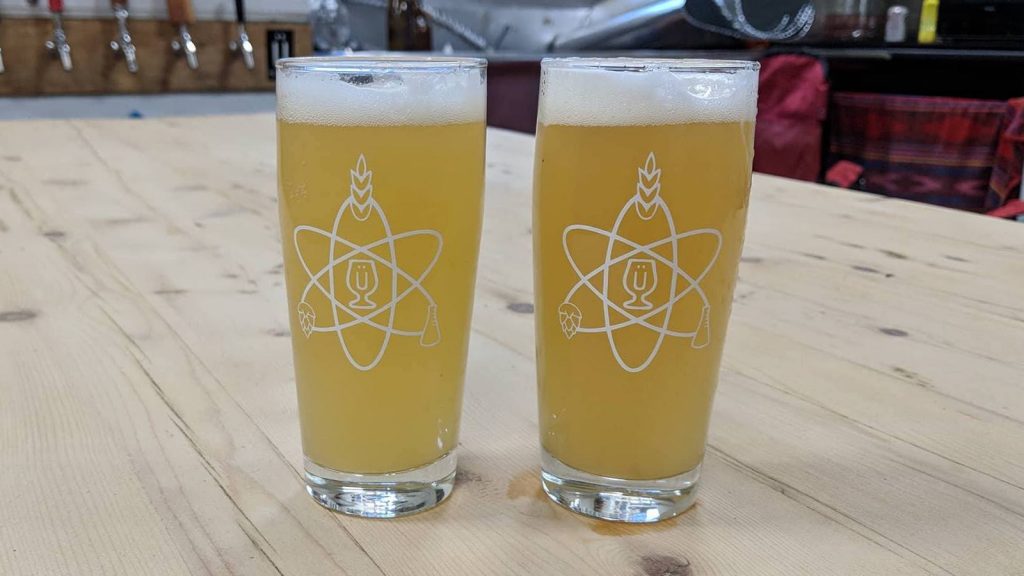
| RESULTS |
A total of 21 people of varying levels of experience participated in this xBmt. Each participant was served 1 sample of the beer made with flaked oats and 2 samples of the one made with wheat malt then asked to identify the sample that was unique. At this sample size, 12 tasters (p<0.05) would have had to correctly identify the flaked oats beer as being different in order to reach statistical significance. In the end, only 7 tasters (p=0.58) accurately identified the unique sample, indicating participants in this xBmt were unable to reliably distinguish a NEIPA made with flaked oats from one made with the same amount of wheat malt.
My Impressions: I’ve always considered flaked oats an essential part of New England IPA thus expecting a night and day difference between these beers, but I was shocked by how similar they were. While I could’ve sworn I perceived a difference in earlier samples, my triangle test performance proved otherwise as I was only correct on 1 out of the 6 attempts. Thankfully, both beers were deliciously hoppy, something I’d been craving for awhile.
|DISCUSSION |
A fairly commonly held idea held among brewers is that beers made with a high proportion of wheat malt tend to have a subtle yet noticeable tangy characteristic to them, not tart like a sour beer, just a slight sharpness not typically found in all barley malt beers. Having experienced this myself, I had little doubt participants in this xBmt would be able to reliably tell apart a NEIPA made with flaked oats from one made with wheat malt. Needless to say, I was legitimately shocked when the results didn’t confirm my expectations and even more so that my performance on multiple triangles, despite being completely aware of the variable, was so poor.
Considering prior xBmt results showing tasters couldn’t reliably distinguish a NEIPA made with flaked oats from one made without any adjunct, I’m more curious than ever about the impact wheat malt has on the flavor of other beer styles it’s commonly used in. Would a Blonde Ale made with 80% wheat malt and 20% Pale malt taste noticeably different than the same beer made with 100% Pale malt? I also wonder if the purported benefits these types of cereal grains are said to have on head retention actually hold up.
With all the talk lately about NEIPA being more sensitive to oxidation than other styles, which some have hypothesized is due to the presence of certain metal ions, namely manganese. Whereas the manganese content in barley is about 1.2 mg per 100 g, wheat contains 3.9 mg per 100 g and oats have an even higher 4.9 mg per 100 g. To see if there was a difference in oxidation effects between the flaked oats and wheat malt beers, I collected samples of each beer in PET bottles once they were ready to serve and placed them in a room temperature environment for observation over 5 days.

I was surprised to observe basically no color change in either beer. For the sake of comparison, I pulled a couple glasses of each beer from the tap as well.
It’s entirely possible that given enough time, at least one of these beers would begin to darken, as they were both only 10 days out from being kegged at the last the comparison. Here’s the real kicker– to test the extreme, I left a sample of the flaked oats beer in an uncovered cup over 4 days and began documenting the changes after 48 hours.
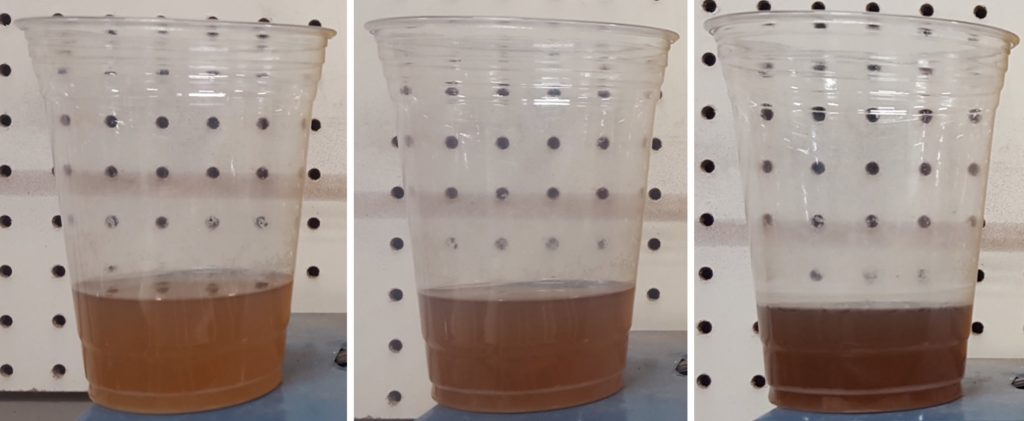
I’ve left many a half full glasses of beer out over the years and never have I witnessed such a drastic change. Wow. Regrettably, I didn’t think to run this test with the wheat malt beer, though it’s certainly something I plan to do in the future. I’ll likely continue using flaked oats when making NEIPA…
If you have thoughts about this xBmt, please feel free to share in the comments section below!
Support Brülosophy In Style!
All designs are available in various colors and sizes on Amazon!
Follow Brülosophy on:
FACEBOOK | TWITTER | INSTAGRAM
If you enjoy this stuff and feel compelled to support Brulosophy.com, please check out the Support Us page for details on how you can very easily do so. Thanks!

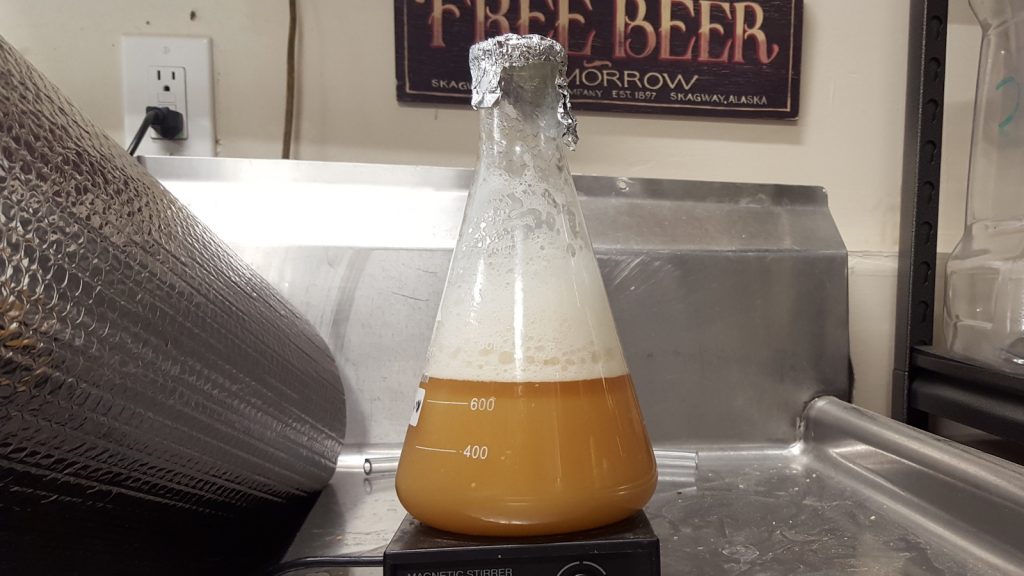

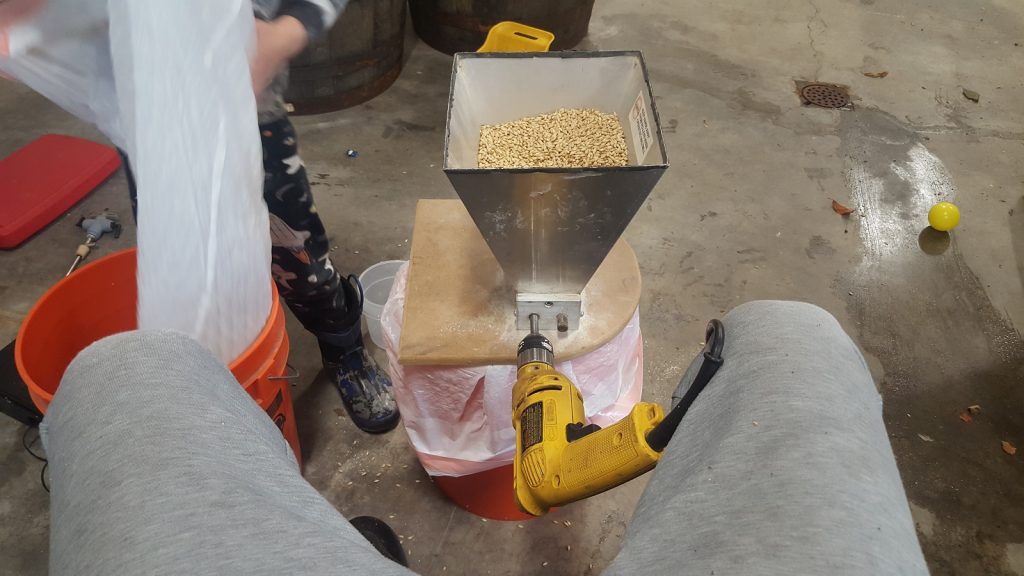
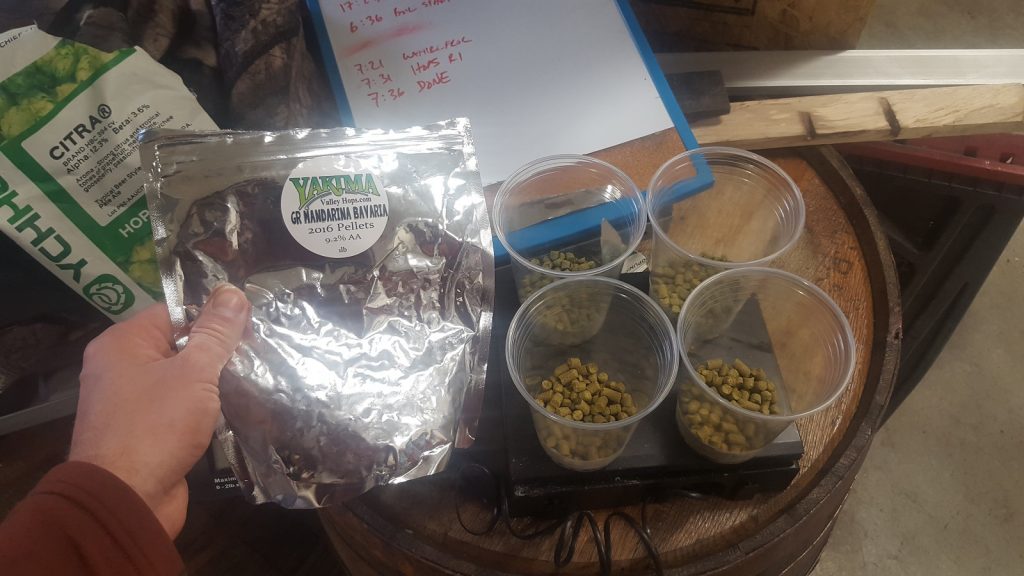
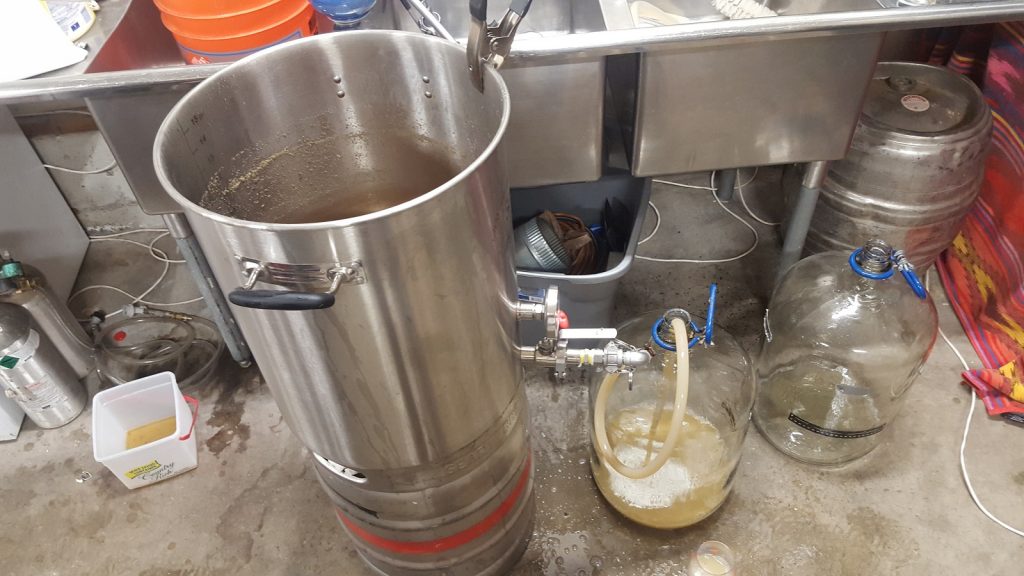
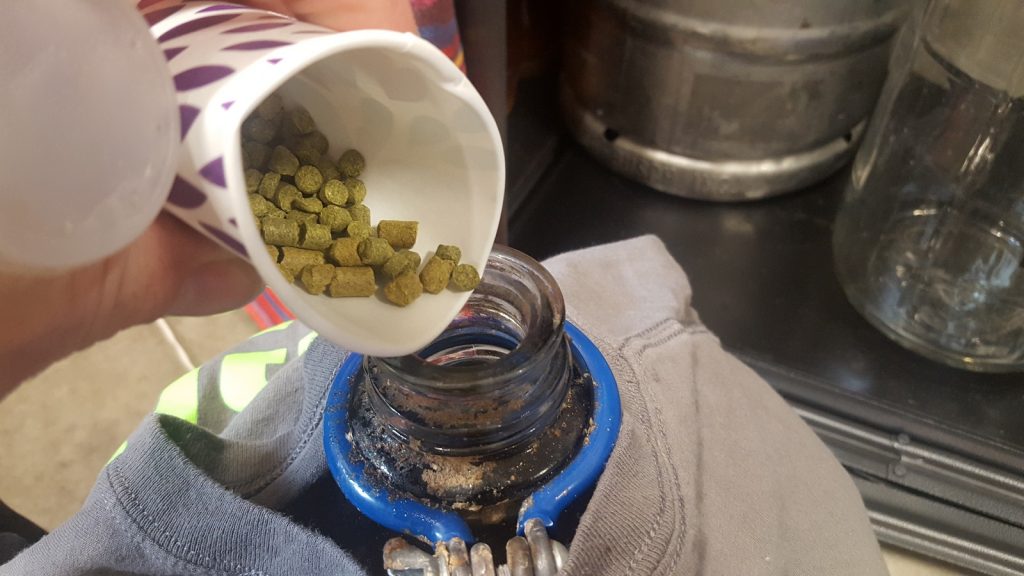
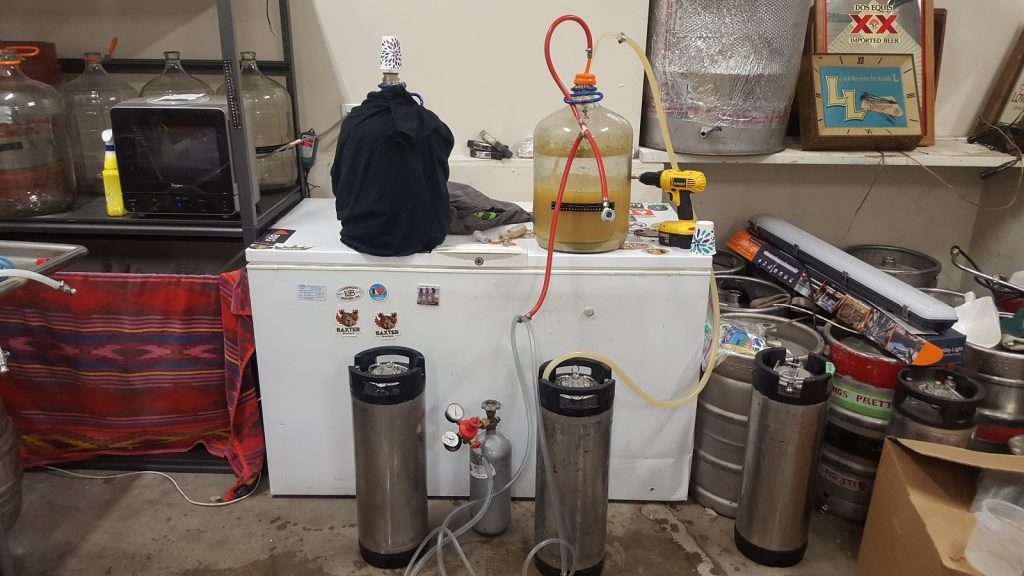
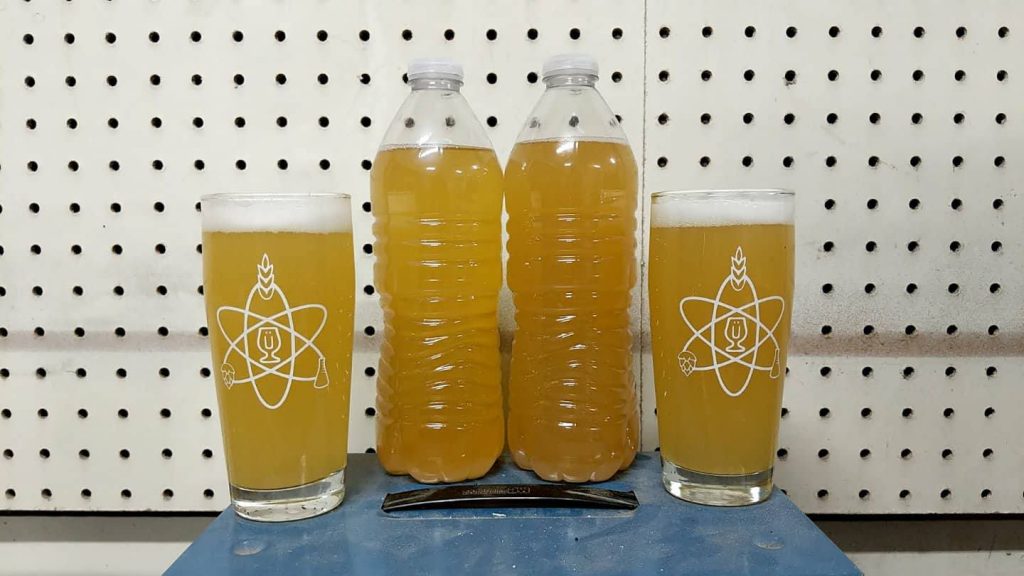










34 thoughts on “exBEERiment | Flaked Oats vs. Wheat Malt In A Hazy IPA”
I can’t really taste (flavor or body) flaked oats up to 20% in an NEIPA. I did try an NEIPA that had a nice oaty taste. Turns out they used oat malt. Might try that next if I want an oaty taste.
I’ve recently taken to adding significant amounts of malted wheat to quite a few brews. I think wheat definitely adds a lovely smoothness to the beer but I find oats can actually go to far and almost give a greasy mouthfeel. I mash low to dry the beer out but use the wheat to ensure the beer doesn’t feel too thin.
I was just looking at your pictures. Did you do a pressure transfer from your carboy to your keg to prevent oxygen exposure?
I use a small amount of pressure to get the siphon going and once it’s going I drop it to almost nothing just to keep a small blanket of CO2 in the carboy.
^^Also, I’m assuming you didn’t cold crash in order to prevent oxygen exposure from suck-back?
That is true.
Hello, I have a question about the recipe you posted. You mention a hop stand addition but I don’t see it listed in your recipe section under hops. What hops did you use and for how long? Thanks!
Should be fixed now, but if you can’t see it I used 30 grams of Citra and mandarina for 20 minutes at 182F.
Whoops! Sometimes when exporting from BeerSmith to XML, it messes up the hop timing. Recipe now fixed, thanks for pointing it out!
In your picture with the PET bottles and 4 days. It certainly looks to me that the bottle on the right hand side is darkening more quickly than the one on the left. Does anyone else see it?
I see it but it’s subtle.
Looks that way to me too
I noticed the same. I would be interested in some more testing on color in NEIPA’s. It seems to be the hardest thing for homebrewers to accomplish in the style (the glowing brightness). I have seen some pretty wild set-ups to limit o2 and achieve that bright color.
I was thinking the same thing ever so slightly. But very hard for me to tell.
Maybe this is the Blue Dress syndrome. Some see it and some don’t. Its clear as day to me (not subtle) that the one on the right gets darker…but then again I saw the blue dress as blue too, while many didn’t. Some of us have better cones than others. Sensitive topic with the misses.
How about a test between different hops in NEIPA. I mean that while everyone uses Citra, Mosaic, Azacca, Mandarina, Simcoe, Amarillo, etc it would be really interesting to see how some of those old continental varieties might work? Could that biotransformation turn f.e classic English hops to something, like EKG, Fuggles (oh yes, U all hate it don’t U), Challenger, Target, etc or with noble hops? like Hallertau, Saaz, Styrian, Tettnanger, Spalt..
New England goes to Old England vs Noble hops. Atleast I haven’t seen such an attempt.
When I use oats, they get calculated into the OG like malted barley which is usually a little shy(nothing significant). You seem to have similar results. The FG is a little higher also(I figured less fermentables). What are the oats contributing to the OG? As you state ” the malting process is responsible for developing the enzymes that ultimately convert the starches in grain into fermentable sugar during the mash– whereas flaked oats cannot self-convert” This article mentions that oats gelatinized at typical mash in temps : http://scottjanish.com/case-brewing-oats/ Thanks! -Chris
In the PET bottle test, which is the oats and which is the wheat?
Oats is the lighter one on the left.
Thanks!
I agree. The pet bottle on the right is getting darker. I think the test regarding color needs to be done over a longer period of time. 5,10,15,20,25,30 Days. 5 Days isn’t enough time. Surprised by the results of the triangle test though
I agree the one on the right is definitely darkening. Not that subtle.
Thanks for running this exBEERiment. For me, the difference was that the hop aroma was a little brighter in the oat beer but the hop flavor was brighter in the wheat beer. I can only imagine that the difference would fade quickly over time.
Curious how this would turn out with flaked wheat vs. flaked oats. I usually use a 50/50 combination which accounts for a total of 35% of the grain bill for my NEIPAs.
That last “open cup” test is shocking. That much change in color thay quickly is crazy town.
Nice to see London III get some love. I have a sweet stout bubbling away right now with it. Fermenting it at 60-62*F really lets it be clean.
I’m now curious how my NEIPA that I’m brewing this weekend with a combo of Flaked wheat and and Flaked Oats (1 lb each) coupled with 8 oz wheat malt will turn out.
Thanks for this interesting comparison! We’re currently trying to emulate your recipe as represented in the above and were wondering how to interpret the dry hop schedule as specified in the recipe. Could you validate if the following interpretation is correct?
The dry hop charge of 2x 70g is added on day 3 of fermentation and left in for 7 days (since fermentation takes 10 days according to your journal notes) and the dry hop charge of 2x 32g is added on day 8 of fermentation and left in for two days?
Thanks in advance!
Hi! This experiment was really interesting! I’ve seen that you use a carboy for fermenting and rack the beer trying to avoid the trub. If you were using a conical fermenter would you start purging yeast at some point? I’m asking this question both for (this) NEIPAs and other styles.
Thanks for your help!
PS: sorry for my poor English
I’ve found the color change is more attributed to exposure to light. I bottled a NEIPA once when my kegerator was down. Put some in my refrigerator after conditioning and within days they were brown. Went back to the bottles stored in a cardboard box in my basement and they were as yellow/orange as the day I bottled. These were all bottled in standard brown bottles.
I also work at a brewery that produces a NEIPA. After transferring to the Brite Tank, I noticed the beer turning brown in the sight glass on the tank within 24 hours. I nervously drained the site glass and refilled with beer from within the tank. Color was perfect. Sure enough, the next day it was brown again. Oxygen within the tank was verified to be very low.
I like these tests for the NEIPA’s but I wonder why you are using different recipes each time. It’s difficult enough to tease out one variable that makes a discernible difference, but I think it becomes more difficult when you are changing the entire recipe each time you do a NEIPA exbeeriment. Grain bills are different, hop schedule different, yeasts different..I love the exbmnts but I just think you are making it more difficult to find a difference maker when each trial has multiple possible difference makers since the recipe’s aren’t static save one variable.
Have you every tested flaked oats and flaked wheat versus same portions malted oats and wheat? I would love to see how they preform differently in a hazy ipa or pale.
Hello, and thank you for this experiment! Have you ever tried adding ascorbic acid as an antioxidant? Also I am intrigued by the recipe and was hoping to read more about it, it certainly looks delicious!. Would you say it tastes like tropical citrus, grapefruit, or orange juice? I want to make an orange flavored hazy using amarillo and mandarina bavaria, should I include some citra as well? Cheers!
I have replaced about half my flaked oats with flaked chit wheat. An experiment with flaked chit wheat vs flaked oats would be interesting.
Mabosway every second sites and mobile sports login friends – There are
lots of online gambling agent sites scattered on the internet.
Each of these sites has offers and features provided, including the types of gambling games
available. Many online gambling sites without help
allow 1 to 3 types of games and agreed have
excellent games they offer.
Mabosway.com is an online gambling agent site that offers not isolated 1 or 3 types of gambling games but 7 engaging types of
gambling games that you can play. This proves that Mabosway
is the most unmovable betting site that offers not lonely online soccer gambling, but Casino,
Poker, Toto 4D, Bola Tangkas, Fish Hunter and online cockfighting gambling.
This site is known as Mabosway Indonesia for members who come from Indonesia.
Various types of online gambling games are thoroughly
supported by the maximum bolster from Mabosway.com. One of them is the Customer serve feature which is
24 hours standby to facilitate buildup and invalidation transactions for members.
How to register is afterward simple to do, especially for beginner bettors
who are starting to bet for the first time.
How to Apply for Mabosway
How to register mabosway is categorically simple for unsigned people
who desire to begin playing online gambling. You and
no-one else have to click the member NOW button on the house page which will go directly to the registration form page.
After successfully registering you will get a addict ID
as an identity in the game. After anything is done, you are officially joined and become a member.
After you officially become a believer you are offered to pick the type of online gambling game
that you can play. Here are 5 types of favorite
online gambling games that you can feat at Mabosway.com.